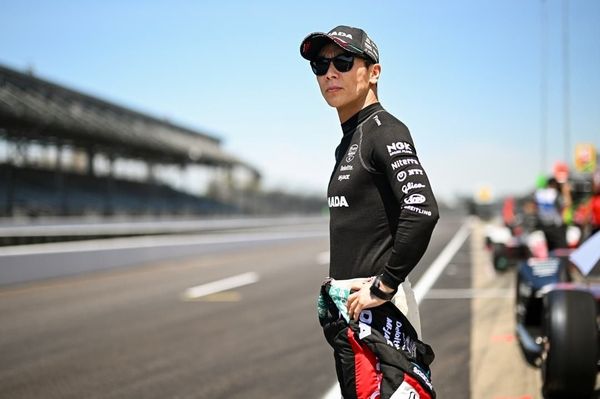
When I speak to Adam Ferguson, the photographer is in a caravan park in Broken Hill, a mining town in western New South Wales. He has been travelling through the outback, he says, driving “an epic amount of miles” in a last “mad dash” to take more images, including shots of recent bushfires and a heatwave-induced mass die-off of fish.
The works are part of the poetically titled Silent Wind, Roaring Sky photo series, which will feature in an exhibition at Somerset House in London and in a book to be published by GOST books next year. The title refers to a peculiar ambience in the vast, sparsely populated Australian interior. “There’s kind of an eerie quietness to it,” he says. “And the expanse of sky becomes incredibly loud and poignant.”
Ferguson’s mother grew up in a small farming village in western New South Wales. Some of his early childhood years were spent there, which helped inform the project: “It was about glimpses and memories that I have from childhood.”
Following a period of scrabbling for jobs after studying photography at the Queensland College of Art – including working as a deck hand on a yacht belonging to Queen’s Roger Taylor – Ferguson, who is now 44, moved to Paris, then India to pursue documentary photography. He self-funded a trip to Afghanistan to photograph the war there in 2008; a military embed led to a 2009 cover story for Time magazine (“Back in a time when a cover like that had gravitas”) which helped to establish his name. Over the next few years he continued to document conflict but gradually shifted to portraits, with work published and exhibited widely.
In 2022, Ferguson received photographer of the year at the Sony World Photography awards for his series Migrantes, featuring people in Mexico about to cross the border into the US. In each shot the subject holds the camera’s shutter release, allowing them to choose when to take their own image after Ferguson had set up.
But after years of travelling and creating images around the world, Ferguson started to look towards home. The Silent Wind, Roaring Sky series emerged out of an interest in examining the overlapping effects of Australia’s difficult colonial history, the climate crisis, globalisation and the simple facts of life in the country’s rural expanse. He cites Richard Avedon’s classic 1979 portrait series In the American West, for which the photographer travelled through 21 western states, as an initial inspiration, though it is stylistically different.
“As Australians, integral to our national psyche is this notion of the bush and the farmer and the outback. And that’s been pretty pivotal in developing, at least, an Anglo national identity,” he says. “But I think the mainstream romanticises it. Methods of pastoralism, which we inherited from an English model, don’t necessarily fit this landscape and ecosystem. Our indigenous issues are steep. And I just felt like no one has really photographed the interior of the country in a way that is an effective critique. So I was like: ‘That’s my story.’”
Silent Wind, Roaring Sky is at the Sony World Photography awards exhibition. Somerset House, London, 14 April to 1 May. Silent Wind, Roaring Sky will be published by GOST Books in February 2024.
Scorched earth: five highlights from Silent Wind, Roaing Sky
Drought Time, Epping Farm, 2018 (main picture)
“There is zero grass, so the farmer has to buy food. He puts grain in a tractor, drives along and drops it through the paddock. So all these sheep run to a line of grain, that’s why they’re all lined up. I was chasing him around in the tractor, then looked over at this dead parched tree. And I ran over and made this landscape of the tree with the sheep feeding in the background.”

Lake Huffer Cattle Station, 2017
“I went to this farm, or cattle station, because the owner’s husband had hung himself. And she took me for a bit of a tour of the property. What you’re seeing is a desert, basically, but in big rains, it turns into a lake. They hang the chairs up so when the water comes up, they don’t float away. Somehow it felt poignant given the story of that cattle station.”

Come By Chance Christmas Tree, 2019
“There had been a seven-year drought across New South Wales. This was taken in a little town called Come By Chance. You’ve got these kids playing on man-made structures in this parched earth and this almost apocalyptic sunset in the background. So it felt kind of allegorical in a way.”

Drought Time Death Pit, Epping Farm, 2018
“I was with Jack Slack-Smith, a multigenerational farmer. He has a farm in Pilliga in New South Wales. He’d just been smashed by a drought. When the sheep can’t eat natural feed, they get very weak – even feeding the sheep with hay, they still get a lot of deaths. So this is his death pit. This is where he throws livestock that doesn’t survive the drought.”

Kangaroo Shooter’s Offsider, 2017
“I went out with a ’roo shooter, a guy who goes out and kills 70 kangaroos a night and sends them off to a processing plant. I decided to photograph a ’roo shooter because it’s like an archetype of a character that exists in the Australian bush, and is in decline. This is the offsider – he’s the guy who gets out of the car and grabs the carcass.”







